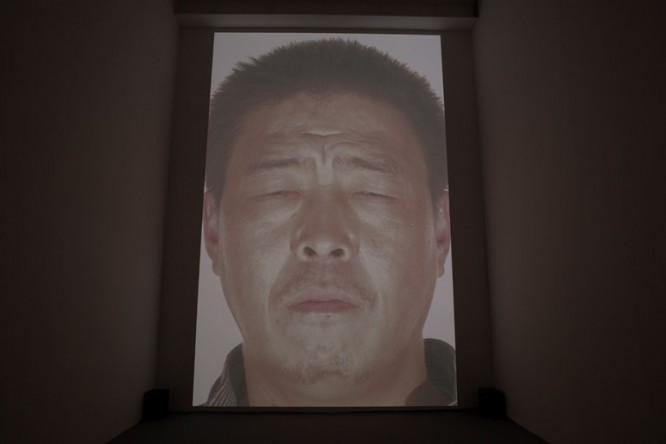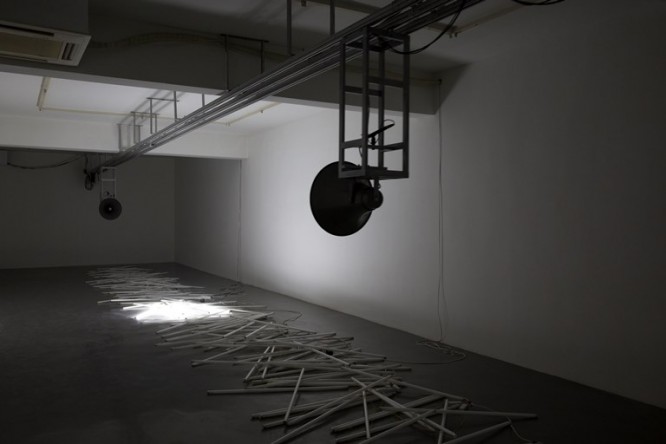“Because…Therefore”—solo exhibition by Zhang Peili
Boers-Li Gallery (1-706 Hou Jie, 798 Art District, No.2 Yuan, Jiuxianqiao Lu, Beijing 100015, China), April 18–May 31, 2014
Zhang Peili—who is no doubt tired of being labelled with the well-deserved moniker of the “Father of Chinese video art”—continues to make new work that defines and escapes the possibilities of the medium. Now halfway through his third decade working primarily with cameras, screens, projectors and speakers, he has successfully learnt to isolate several key properties of the viewing experience and then re-embed them in unexpected materials and situations. For his second solo exhibition at Boers-Li Gallery, and his first in its smaller 798 space, Zhang presents three discrete projects that produce an interconnected sense of what it means for the body to enter into a relationship with the screen.
Entering the space, the viewer immediately confronts a flat LED monitor accompanied by a red LCD screen (“Image Unveiled”, 2014): the former is occupied a hazy image of what appears to be human skin depicted in red dots on a light background, while the latter displays a number that grows a digit larger each time someone approaches the screen. The image, apparently, becomes clearer over time in a way that is not unlike Zhang’s earlier installation “Lowest Resolution” (2005-2007), in which a pornographic video (marketed in state-operated bookstores as an educational aid for newlyweds) on a tiny monitor becomes increasingly blurry with each step the viewer takes towards it.
There are further such installations on the ground floor, all involving similar close-up images of skin; but before reaching them, the viewer is likely to be distracted by another room housing an immensely tall, vertically-oriented high-definition projection entitled “Portraits of 2012” (2012). All is dark, and all is silent—until suddenly, with a loud crack, one entire wall lights up radiant white. Slowly, a face comes into focus, and it becomes clear that he—the figure recorded—is acclimatizing to a blindingly bright flash in precisely the same way as the viewer. As occurs throughout Zhang’s more formally oriented work, the distance between screen and lens is reduced almost infinitely. Ironically, as his career is increasingly historicized and recognized as part of the canon of contemporary art, pieces like this one invariably lead to references to Geng Jianyi, one of Zhang’s earliest and closest collaborators and a prolific painter of floating faces for a few years in the 1980s, and Li Yongbin’s moving videos of little other than his own and his mother’s faces. Zhang’s work, at least in this case, is almost completely emotionless, a genre in which he is extremely successful: by stripping away the potential affect or even narrative content of a situation like this (what he and other artists of the 1980s might have called “humanist residue”), the artist is able to bring the focus of his audience almost exclusively to the technical being of the work. In this case, it is the light—not the face or the connection between actor and viewer—that brings power to the work.

张培力,《2012的肖像》,录像投影,彩色,有声,22’09”,4个版本, 2012

张培力,《碰撞的和声》,声音装置,轨道,喇叭,电脑,日光灯管,2014
Upstairs, a final installation, “Collision of Harmonies” (2014), finds two large megaphones facing each other on a track on the ceiling, moving back and forth towards and away from each other over a pile of broken fluorescent light bulbs strewn across the ground, some of which which light up as the speakers pass above them. They begin as vocal exercises, but their sound increases in pitch and, seemingly, volume as they approach each other; a feedback loop begins, but the viewer is relegated to one side, viewing the procedure from an angle rather than entering into the technical process directly. One is reminded, in some ways, of “A Necessary Cube” (2011), in which a silver inflatable cube occupying the entirety of a room expands towards the viewer before slowly recoiling and shrinking backwards. In both cases, Zhang has managed to create situations that consider the realities of the moving image without actually including video at all.
Zhang Peili is at his best at his most minimal, reducing the elements of his chosen medium to its most basic constituent components: light, darkness, rectangles, buzzing. His explorations in this direction, as much as they have contributed to an extremely productive discourse about the technological realities of contemporary society and helped define the contours of video art in the twenty-first century, have also engaged the art world by encouraging a generation of young artists to rebel against his influence. Artists like Li Ming, Lin Ke, and Zhang Lehua, members of the Doublefly collective who emerged from the scene around Zhang Peili at the China Academy of Art in Hangzhou, continue working in video but in a way that he might find meaningless: everywhere he subtracts, they add; everywhere he insists, they shrug their shoulders and move on; everywhere he declares, they laugh.
This, perhaps, is the greatest sign of Zhang’s talent and lasting legacy, offering within his practice and community both thesis and antithesis. His position is clear, but the conceptual space it creates is expansive.

张培力,《碰撞的和声》,声音装置,轨道,喇叭,电脑,日光灯管,2014

张培力,《被显现的图像》,感应装置(静止图像由感应器和电脑控制呈现),彩色,无声,感应器,液晶显示器,电脑,版本1/1, 2014